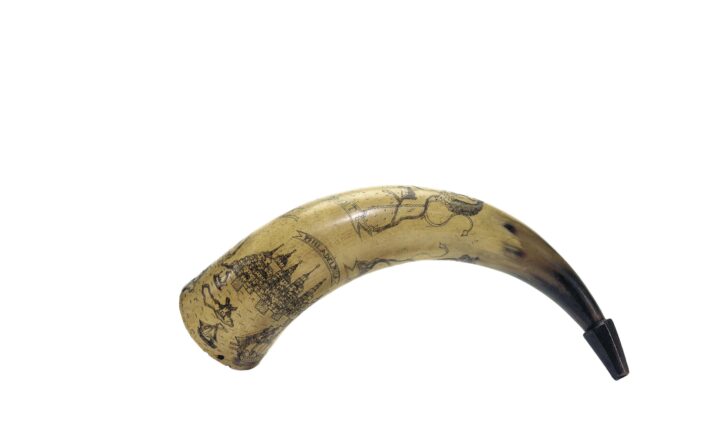Engraved Powder Horn
Artist Unknown

Description
March 28, 2009
Made from cow, ox, or buffalo horn, powder horns were commonly used in the eighteenth century to safely store and carry gunpowder. Their polished surfaces often provided a rich canvas for a professional carver.
This powder horn is engraved with the Royal Coat of Arms of the United Kingdom, which features a lion and unicorn holding a shield above a banner that states dieu et mon droit (“God and my right”), referring to the monarch’s divine right to govern. The shield is surrounded by a belt or garter upon which is emblazoned Honi soit qui mal y pense (“Evil unto them who think evil”), the motto of the Order of the Knights of the Garter, an ancient and exclusive British chivalric order established by the monarch.
The bottom half of the horn is engraved with a cityscape of Philadelphia that is remarkably similar to prints and engravings of the city dated to the mid-eighteenth century. This powder horn was not meant for actual use and was most likely a presentation object or gift to a high-ranking British officer stationed in Philadelphia, probably during the period of the French and Indian War (1754–1763).
Subject Matter:
The provincial carved powder horn is an indigenous North American art form. Made from the cow, ox or buffalo horn, powder horns were commonly used with 18th century muskets to safely store gunpowder, and their polished surfaces often provided a canvas for a professional carver. This work is engraved with the Royal Coat of Arms of the United Kingdom and a cityscape of Philadelphia, symbolizing the position of Philadelphia in the early history of the founding of America.
Physical Description:
Animal horn engraved with the Royal Coat of Arms of the United Kingdom, in which a crowned lion and a chained unicorn supporting a shield stand above a banner with the motto “dieu et mon droit” (which directly translated from French means “God and my right” referring to the monarch’s divine right to govern which has been used as the motto of the British monarch since it was adopted by Henry V (1413-1422)). The shield consists of four quadrants: the first quadrant contains four lions, the second contains three fleurs de lis, the third contains a mermaid and a harp, the fourth contains three lions and a stag or dog-like animal. Surrounding the shield is a belt or garter upon which is emblazoned “Honi soit qui mal y pense” which means “evil unto they who think evil,” the motto of the Order of the Knights of the Garter, an ancient exclusive British order consisting of 25 members who were selected by the king of England. Near the base, the horn is engraved with a cityscape of Philadelphia from the harbor with numerous buildings, towers, boats and ships, and a man with a rifle shooting at a stag or lion in the distance.
Usage Rights:
If you are interested in using an image for a publication, please visit https://umma.umich.edu/request-image/ for more information and to fill out the online Image Rights and Reproductions Request Form.